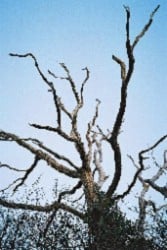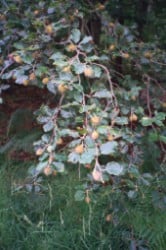LIVING WITH TREES
KEEP YOUR EYES OPEN
The best tools for looking after your trees are your eyes. Watch your trees and see how they change. If they begin to look unhealthy or unsound, call in professional advice.
ARE TREES DANGEROUS?
 | Nobody can guarantee that a tree is completely safe, but most trees will be sound and healthy enough most of the time. A tree may be big, or tall, or have long heavy branches, but still be safe - trees adapt by growing strong enough to take the forces on them. Many trees hollow out over time quite naturally, and may even be safer hollow than solid. Trees absorb wind energy by swaying - if they didn’t sway they’d snap! Call in a tree consultant if a tree moves right down to the ground, or if the ground moves. Ivy can increase the windload, but it gives shelter and food for invertebrates and birds. Only cut it back if your garden is especially exposed or if the ivy is blocking light from the tree’s leaves. |
DANGEROUS GARDENERS
Ordinary gardening can damage your trees, especially the roots, through mechanical damage, compaction, or heat: Make sure you:
- Don’t change the ground level around trees - don’t remove or add soil below trees;
- Don’t cover the soil around roots with anything heavy which could suffocate them;
- Don’t cover the soil around roots with hard impervious surfaces which will stop air and water getting through;
- Don’t mow or strim close to trees - plant ground cover and / or mulch instead;
- Don’t put your compost heap below trees - heat and compaction can kill roots;
- Don’t light bonfires under or near trees - the heat can kill roots, bark, cambium, leaves and buds.
GREEN GARDENERS
Good gardening can make the best of trees.
- Free compost - all trees drop dead leaves. Some trees naturally shed bark, and most trees will shed twigs and small branches as part of their natural pruning, when other branches shade them out. You can turn all of these into leafmould and compost. However, if big branches fall, there may be something wrong - get professional advice.
- Beansticks, trellis, fences... click here for ideas.
TREES AND HOUSES
If you are trying to move house, your surveyor may be concerned about trees nearby - get a report from a tree consultant. Ask your insurance company if your cover includes damage to or from trees.
SHOULD YOUR TREES BE ‘UNDER CONTROL’?
No! Trees grow! A tree will regrow after it is pruned. You can keep it to a certain size only by spending money as long as it lives to have it pruned regularly. It’s better to learn to live with the tree at its natural size, or to consider replacing it with a tree which will naturally grow to a smaller size.
TREE INSPECTIONS
| Many people assume that tree branches and twigs are like hair that “needs” a regular “trim”, but leaves are more like the trees’ guts and lungs - we don’t need to have our vital organs pruned, and neither do trees! Unlike us trees can recover from having bits cut out, but pruning does open up wounds, and these may lead to decay. Tree surgery is usually only needed because people are competing with each other and with the trees for space. The smaller the risk that the tree or bits from the tree could fall on somebody else, the smaller the need for tree surgery. If any of your trees overhang public land, or somebody else’s private property, you should have your trees regularly inspected by a tree consultant who has professional indemnity insurance. |  |
Page last updated on: 07/01/2013





